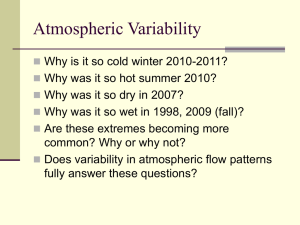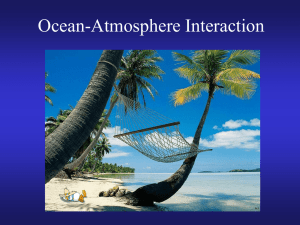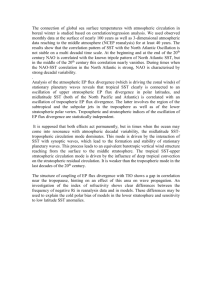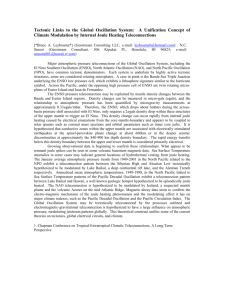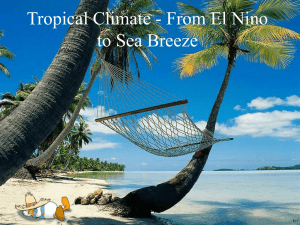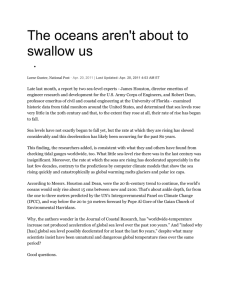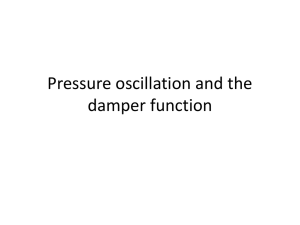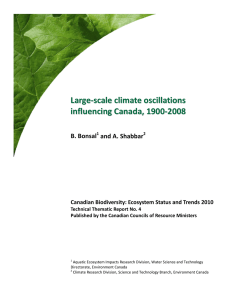Lecture - Bama.ua.edu
advertisement
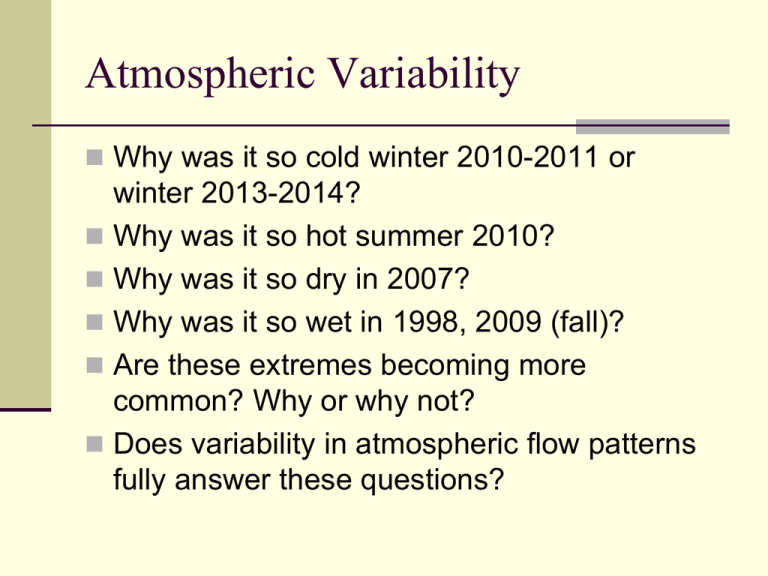
Atmospheric Variability Why was it so cold winter 2010-2011 or winter 2013-2014? Why was it so hot summer 2010? Why was it so dry in 2007? Why was it so wet in 1998, 2009 (fall)? Are these extremes becoming more common? Why or why not? Does variability in atmospheric flow patterns fully answer these questions? Atmospheric Variability Temporal weekly, monthly, seasonal, annual, decadal Spatial (x,y) Global, synoptic, regional, mesoscale, microscale, sub-micro Vertical (z) Surface, 1000mb, 925, 850, 700, 500, 300 Trends? Natural or anomalous What is a teleconnection AMS: 1. A linkage between weather changes occurring in widely separated regions of the globe. 2. A significant positive or negative correlation in the fluctuations of a field at widely separated points. Most commonly applied to variability on monthly and longer timescales, the name refers to the fact that such correlations suggest that information is propagating between the distant points through the atmosphere.” Pressure fluctuations SST Height anomalies (700, 500mb) Associations with circulation indices http://www.esrl.noaa.gov/psd/data/climateindices/list/ The North Atlantic Oscillation (NAO) Pressure dipole in North Atlantic centered near Iceland/Greenland and over the Azores Icelandic Low vs Azores High Tendency for either both weak or both strong Dominant mode of Variability in Atlantic Winter The NAO index is obtained by projecting the NAO loading pattern to the daily anomaly 500 millibar height field over 090°N. The NAO loading pattern has been chosen as the first mode of a Rotated Empirical Orthogonal Function (EOF) analysis using monthly mean 500 millibar height anomaly data from 1950 to 2000 over 0-90°N latitude. (NCDC) The North Atlantic Oscillation The North Atlantic Oscillation Dec – March Temp correlations Dec – March Precip correlations 58.0 Bama state averaged temp Dec-Feb 53.0 48.0 43.0 38.0 2009 2004 1999 1994 1989 1984 1979 1974 1969 1964 1959 1954 1949 Arctic Oscillation (AO) or NHam Cyclonic circulation of upper level winds around the Arctic Latitude poleward of 55°N Positive = stronger winds- confines Arctic air More zonal Negative = relaxed winds- Arctic air oozes southward AO index is obtained by projecting the AO loading pattern to the daily anomaly 1000 millibar height field over 20°N-90°N latitude Winter AO 58.0 Bama state averaged temp Dec-Feb 53.0 48.0 43.0 38.0 2009 2004 1999 1994 1989 1984 1979 1974 1969 1964 1959 1954 1949 Current Phase Pacific North American (PNA) Quadripole pattern of 500mb height anomalies All months except June and July winter Center locations Similar signs south of Aleutians and over SE U.S. Hawaii and InterMountain U.S. and Canada The PNA index is obtained by projecting the PNA loading pattern to the daily anomaly 500 millibar height field over 090°N. The PNA loading pattern has been chosen as the second mode of a Rotated EOF analysis using monthly mean 500 millibar height anomaly data from 1950 to 2000 over 0-90°N latitude. PNA 58.0 Bama state averaged temp Dec-Feb 53.0 48.0 43.0 38.0 2009 2004 1999 1994 1989 1984 1979 1974 1969 1964 1959 1954 1949 El Nino Southern Oscillation (ENSO) Both a SST and pressure fluctuation in the tropical Pacific ~ 5-7 year periodicity Most significant atmospheric/oceanic coupling in the world El Nino = warmer than normal SST La Nina = colder than normal SST Southern oscillation= pressure flip-flop http://www.cpc.ncep.noaa.gov/products/analysis_monitoring/enso_update/sstanim.shtml Southern Oscillation Index (SOI) Standardized difference in MSLP between Darwin Australia and Tahiti (T-D) Pressure normally higher over Tahiti and lower over Darwin Slow east to west flow of tropical water Nino Regions Oceanic Nino Index Running mean of the Nino 3.4 region At least 5 consecutive overlapping months above (below) 0.5°C sst anomaly ENSO Impacts Alabama Impacts http://www.cpc.ncep.noaa.gov/products/precip/CWlink/ENSO/box_whiskers/index.php Pacific Decadal Oscillation (PDO) Discovered 1996 (Hare and Mantua) Leading principal component of Northern Pacific SST variability Similar to ENSO Long-lived ENSO Greater SST variability in mid latitiude Pacific Pacific Decadal Oscillation (PDO) Positive Negative El Nino vs positive PDO Table 1: summary of North American climate anomalies associated with extreme phases of the PDO. climate anomalies Warm Phase PDO Cool Phase PDO Ocean surface temperatures in the northeastern and tropical Pacific Above average Below average October-March northwestern North American air temperatures Above average Below average October-March Southeastern US air temperatures Below average Above average October-March southern US/Northern Mexico precipitation Above average Below average October-March Northwestern North America and Great Lakes precipitation Below average Above average Northwestern North American spring time snow pack Below average Above average Winter and spring time flood risk in the Pacific Northwest Below average Above average Thermohaline Circulation Atlantic Multidecadal Oscillation (AMO) Fluctuation in detrended SST in north Atlantic (0 – 70°N) AMO index 10 year running mean Relationships to speed of thermohaline circulation AMO and hurricane activity AMO and hurricane activity PDO and AMO drought Quasi Biennial Oscillation (QBO) Oscillating (E-W) stratospheric winds 10 – 100 mb above the equator 20 – 36 month periodicity Impacts Spike in ATL hurricane activity during west (positive) zonal flow May impact Asian monsoon and ENSO Quasi Biennial Oscillation (QBO) Madden Julian Oscillation 30 – 60 day oscillation, Tropical Indo-Pacific Eastward wave propagation of anomlaous rainfall low OLR 4-8 m/s Impacts trop and subtrop, precip, temp, and circulation Most prominent NH winter U.S. Impacts Increase frequency/intensity west coast precip Eastern cold air outbreaks http://web.archive.org/web/20070612204448/http://w ww.apsru.gov.au/mjo/index.asp Madden Julian Oscillation MJO- OLR and pressure MJO Phase Diagram http://www.cpc.ncep.noaa.gov/ products/precip/CWlink/MJO/C omposites/Precipitation/ MJO and Atlantic Hurricanes Phase 1 and 2 support a more active regime of Atlantic convection ACE > 76 91.5 major hurricane days (1974 – 2007) Phase 6 and 7 less active ACE < 36 20.5 major hurricane days (1974 – 2007)
